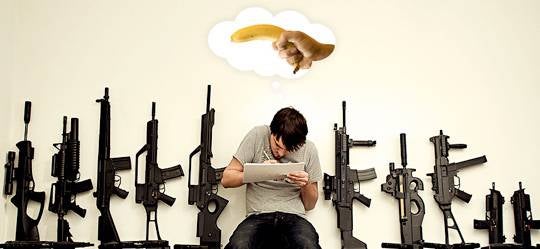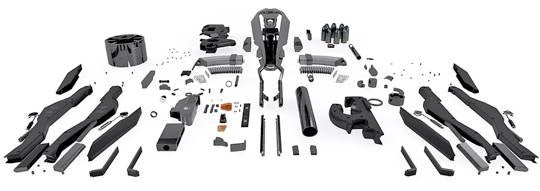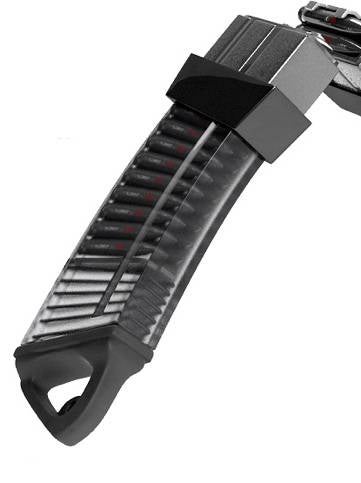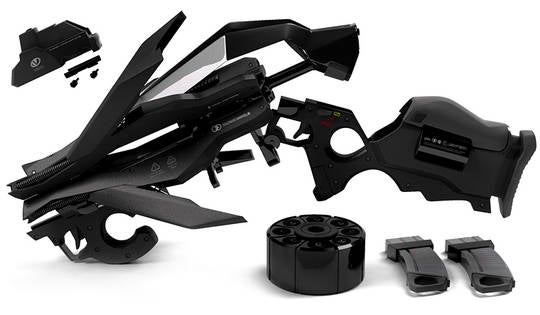[ This blog post was written by Pascal Eggert. Pascal is an incredibly talented graphics designer, firearm enthusiast and reader of The Firearm Blog. He works for Crytek, a major German game studio, where he designs guns for video games. This article is drawn from his personal experience in the game industry. The images below are Pascal’s personal work and are not related to his work at Crytek ]
Guns in games are like guns in movies: it is all about looks, sounds and clichés. Just like in the movies, games have established a certain perception of weapons in the mind of the public and just like in movies games get almost everything wrong. Many of us in the game industry know this. Because games are looking more realistic and appear to simulating reality better but the guns do not, a common misconception is that those of us in the game industry don’t know anything about guns. The fact is that we are not trying to simulate reality but are creating products to provide entertainment.

At the core of every game there is often a simple underlying gameplay-mechanism and everything on top is just eyecandy. So think of a modern egoshooter (otherwise known as First-Person-Shooter or FPS) more like chess with hyper-realistic chess pieces e.g. real horses for knights and a real landscape instead of a chess board. In real life horses don’t move in L shapes like knights do on a chess board. The chess game rule governing knight movement is designed to make the game fun and challenging, not to replicate the movement of a real knight riding on a real horse. It is the same with guns in games, there is no fun in holding virtual breath and nobody (other than The Firearm Blog readers) want to watch how a revolver is reloaded cartridge by cartridge. The game gun is a visual representation of a game rule. Because of this, the first decision how a weapon in a game should behave is made by a game designer not a visual designer and even though our representation of real firearms has become incredibly authentic at times, it is still just an abstraction on top of a function.
For me though, and many others, an important ingredient in a fun product is immersion which comes from authenticity. If a 9mm pistol is portrayed as a concrete wall penetrating uber-weapon and a magazine is called a clip, I am just as angry as the next reader of The Firearm Blog. I my personal ambition is to create games that are fun and at the same time immersive through believability. Fortunately there is some common interest between people who know how to maintain firearms and people who know how to create something that is interesting to play. Reloading for example is something that is a great game rule because it creates tension as well as it’s an authentic behavior. Now there are animators who will not be happy hearing how a bolt catch on an AR-15 works because it looks less interesting than pulling the charging handle, but I would definitely argue for the real behavior because it looks more professional and less like a cliché. Another example would be when game designers decide if game guns should have a rail accessory system, because it suggests that the player could modify the weapon. So now you understand why weapons in games behave like they behave. But how do they get into the game?

The process includes a lot of fancy words, but to put it simply it works something like this: if it is based on a real firearm, the game designer makes the decision on how the weapon will work (number of rounds, kills what with how many hits, takes this long to reload etc.) and after that a 3D artist uses a tool like 3DsMax, Maya or Cinema4D to build a very detailed virtual model of the real weapon. If it is a fictional gun then a concept artists will draw pictures of the weapon from various views after the game designer has determined how it should function. The 3D artist then work off of these pictures or real photos, part by part, screw by screw. Next a simpler version of the weapon is built using less shapes (polygons) so your PC, XBOX or PS3 will be able to calculate it in real time. The detailed model is used to generate the in-game model and works sort of as a reference point. Next textures are created by 2D artists to replicate the look of metal, plastic or wood as well as scratches and little details.

When the model is done, the animators, effect artists and coders get their hands on it, in order to implement it in the game. If you look at a first person weapon in the editor software you will most likely see half a gun and two hovering arms. The reason there only is half a gun is because we remove any shapes that cannot be seen by the player during any animation position to save render power and the reason the arms are flying is because most egoshooters render the body of the player either separate or not at all. Now this whole process has several variations for each level of quality in the end result and so to get good results your references at the beginning need to be good.

Unfortunately there are as many real guns in game studios as there are real horses. Hearing that sentence out of context would sound really weird but it is true and is a real pity.
Because if you want to replicate the looks of something you need to at least see it, but using it is even better. You should hold a gun in your hands, fire it and reload it to understand what does what – and at that point you will realize, there is nothing on it that does not have a function – because guns are tools for professionals. Lot of weapon designers in the game industry get that wrong. They think of guns like products for consumers or magic devices that kill people at a distance when really it’s just a simple and elegant mechanism that propels little pieces of metal. Unfortunately 3D artists often only get access to the photos that Google Image Search comes up with if you enter “future assault rifle” or, even worse, pictures from other games and movies that also got it wrong. This may explain a lot of common visual mistakes in games, especially since guns are mostly photographed from the side and egoshooters show weapons from the first person view.

I think about stuff like this a lot and have come to the conclusion that the one thing that is even worse than wrong visual representations of real guns in games are horribly designed fictional guns. In this area a lack of understanding of firearms gets easily multiplied and if you thought an AK47 is a magic device in the first place your sci-fi AK7000 will be a magic device so random it will not convince even the stupidest player. Yes, in the realm of fantasy you can invent whatever you want and find an explanation for any technical problem, but there are still the laws of physics that should be considered. Unfortunately most sci-fi guns are so bad that people just stopped caring about them with no questions asked. Actually making good sci-fi design isn’t that hard – the products of the future are essentially improved versions of present products so if you design for the future you just look at current problems and try to find enabling technologies that could solve these problems and then design the weapon like a tool around these core technologies. Make it functional, realistic and efficient. Now I’m not saying my gun designs are completely realistic, they can’t be by definition since they are sci-fi, but since they are designed around inner workings and ideas to fix current problems, they have at least a certain look of functionality and believability, while still making game designers happy.
Steve says: A huge thank you to Pascal for his insight into the video game industry. Pascal’s personal website is a visual feast. I highly recommend reading his article entitled Creating EPIC, The TITAL C2, The EPIC A1 and The THOR PDW A1. It is my sincere hope that Pascal will one day be working for H&K, FN or another major player in the firearm industry.
 Your Privacy Choices
Your Privacy Choices

